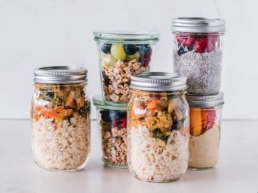By Barbara Martinez Benavides, First Mile Care DPP Coach
As the pandemic continues to recede, many people are excited to find themselves eating more often in restaurants. However, eating away from home can present a challenge if you are making lifestyle changes to stave off or reverse a prediabetes diagnosis. It requires some thought and planning to eat healthily when you prepare your own food, let alone when someone else does it.
In the First Mile Care Diabetes Prevention Program (DPP), coaches counsel participants on how to create and sustain healthy eating habits when away from home, whether dining at a friend’s house or in a restaurant. The challenges you may encounter in restaurants include:
- Tempting food
- No healthy choices
- Not knowing ingredients or how food was made
- Oversized portions
- Wanting to get your money’s worth
- Not wanting to make a fuss by asking questions
However, you can stay on track with your eating goals in restaurants without a lot of effort if you just do a little planning before you go, and ask a few questions once you’re there. It can be as easy as ordering a turkey sandwich with a side salad instead of a hamburger and French fries, or drinking sparkling water instead of soda.
Choosing the restaurant
Restaurants often serve highly processed foods that are high in calories, saturated fat, and salt. In general, you are more likely to find healthy choices at sit-down restaurants, places with a salad bar, vegetarian restaurants, and restaurants offering a cuisine that has many vegetable dishes even if they’re not strictly vegetarian (e.g., Chinese, Ethiopian, Indian, Japanese, Korean, Malaysian, Thai, Vietnamese, etc.). You are less likely to find healthy choices at all-you-can-eat buffets, pizza parlors, burger joints, and most fast-food restaurants. However, there’s usually at least one decent option, and there might be a salad bar.
In order to choose both a restaurant and a meal wisely, it’s a good idea to look at the menu in advance. That will give you more time to think about possible swaps and questions to ask, rather than feeling put on the spot when the waitress approaches you or you reach the counter.
As First Mile Care participant Roberta Varnado explains, ‘I learned a trick for when I go out to eat. My coach, Robert McNeill, explained that most restaurants will have their menus posted to their websites with nutritional information on calories, carbs, sugar, sodium, etc. I didn’t realize that it was possible to find that information so easily, so you can plan your meal in advance and be sure to choose the healthier options.”
With a little advance planning, you can drop into restaurants to pick up menus in-person, or develop the habit of taking photos of menus that look promising. If you save the photos into a folder on your smartphone, you can peruse them at your leisure. Then, when the opportunity to dine out arises, you’ll know which restaurants to suggest.
Deciphering the menu
Once you have the menu in front of you, look for dishes that are low in calories, fat, and sugar; high in fiber and water; and high in vitamins, minerals, and protein. There are some key terms on the menu that suggest an item is a healthier choice. These include adjectives such as diet, light, low-fat and fat-free, along with ingredients such as vegetable oil, whole grain and whole wheat. In addition, look for words that indicate how the food is prepared, such as baked, broiled, grilled, and steamed.
Making substitutions
Once you’re in the restaurant, don’t feel shy about asking questions of the wait staff. They’re usually happy to help you make the best choices so you’re satisfied with your meal — and will tip well! To find out if an item is healthy, you could ask how it’s made, the ingredients in the dish, and the type of oil used to cook it.
It also never hurts to ask for a healthy swap, even if options aren’t listed on the menu. Many servers are willing to order a swap if you ask politely, or if you pay a small substitution fee. Here are some common healthy swaps that restaurants will often accommodate:
- asking to have an item baked, broiled, grilled, or steamed instead of fried
- requesting an item be cooked in vegetable oil instead of lard or butter
- asking for fat to be trimmed from meat, or skin removed from chicken — before it’s cooked
- getting a healthy side dish of salad or steamed vegetables instead of French fries
- swapping zucchini noodles or spaghetti squash for pasta
- substituting cauliflower rice for regular rice
- putting butter, dressing, gravy, sauce, and sour cream on the side
- substituting fruit for other desserts
Don’t overlook the healthy aspect of the beverage you order; water with lemon, sparkling water, or unsweetened ice tea are better drink choices than sugar-laden sodas. You can usually get skim milk for coffee instead of half-and-half, too.
Rightsizing your meal
In addition to finding out if an item is healthy, you’ll also want to make sure you have the right amount of food. Many restaurants serve huge portions, or you may want to try just a small amount of a delicious-sounding item that is high in calories. Appetizers and desserts, especially, are often designed to be shared (and their prices reflect this).
Many people were raised to feel they have to clean their plates, and consequently feel guilty about wasting money if they leave food behind. First Mile Care participant Regina Hasan avoids the temptation to overeat by requesting that half her restaurant meal be put into a takeout container. She does this when she places the order, rather than waiting to the end of the meal.
To make sure you have a healthy amount of food, you could ask:
- for a smaller portion (or even order from the kids’ menu)
- to have an appetizer as your main course
- to share items with your meal companion
- to get a to-go box when you first order your meal
Restaurant dining offers entertainment as well as nourishment. It’s wonderful once again to feel comfortable and safe eating out in a busy place with friends and family. And with a little research into menu ingredients, preparation style, and portion size, you can savor every bite and enjoy a meal out that is as healthy as one at home. The goal of First Mile Care DPP is to help participants create realistic eating habits that intervene with prediabetes, without giving up the food you love or skipping on things you enjoy.
To learn more about how you can benefit from the First Mile Care Diabetes Prevention Program, take the prediabetes risk test and get started today!



